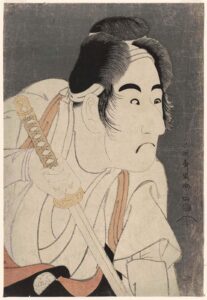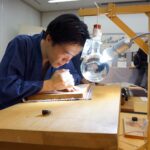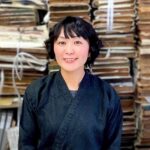On April 6 from 13:00 to 16:00 in the Foyer of Imadate Art Center, Mr. Shoichi Kitamura will demonstrate how to divide a design into color blocks and Ms. Kyoko Hirai will demonstrate printing.
4月6日13:00~16:00、いまだて芸術館のホワイエにて、北村昇一氏のよる「色分けの方法」と、と平井恭子氏による「伝統木版画の摺り」の実演を行います。
Shoichi Kitamura, professional carver
Kitamura Woodblock Studio
After graduating from Kyoto Seika University with a major in woodblock printmaking (mokuhanga), Shoichi Kitamura entered the world of traditional mokuhanga at the publisher “Matsukyu”. Afterwards, he learned carving from Osamu Hotta at the mokuhanga artist Masao Ido’s studio “Kan’eido.’
After graduating from university, Kitamura studied woodblock printing under Akira Kurosaki for about 25 years and also provided support for his production.
He established the Kitamura Woodblock Studio in 2000. Since then, workshops have been held at the studio for those who wish to learn mokuhanga under Kitamura’s instruction.
In order to collaborate with overseas artists, Kitamura travels to their studios abroad and holds workshops and demonstrations there.
In this workshop, he will demonstrate how to divide the design into some blocks (irowake).
- Key-block method (omohan-ho) in traditional yukiyo-e;
- Decomposition method (bunkai-ho) used for works where the image does not have a main outline.
He will explain how to match the registration etc.
彫師 北村昇一
北村木版画工房
京都精華大学木版画専攻卒業後、版元「まつ九」にて伝統木版画の世界へ。
その後木版画家井堂雅夫「歓栄堂」にて堀田治より彫を学ぶ。
大学卒業後、約25年間黒崎彰より木版を学ぶとともに、制作のサポートを務める。
2000年に北村木版画工房開設。
以後、同工房にて希望者にワークショップを実施。
海外作家との共同制作の為現地に赴き制作、ワークショップ、デモンストレーションを開催。
今回のワークショップでは、色分けの方法について実演します。
- 伝統的な浮世絵方式の主版法の摺り返しのとり方と貼り込み方。
- イメージに主たるアウトラインの無い作品の場合に使う分解法。
見当を合わせるために気を付けること等を交えながら説明します。
Kyoko Hirai, Professional Printer
- 1998, after graduating from the Faculty of Fine Art, Kyoto Seika University, majoring in printmaking, Hirai started working under Mr. Keizo Sato, a professional printer at Sato Woodblock Print Studio, Kyoto, and learned traditional woodblock printing techniques.
- Since 2011, she has given demonstrations and workshops at universities and museums in Thailand, the United States, Russia, and other countries as part of a project of the Japan Foundation.
- 2014, she received the title of Kyoto Certified Craftsperson in the genre of Kyo-hanga (Kyoto printmaking).
- 2015, she participated in IMPACT 9, International Print Conference (China Academy of Fine Arts, Hangzhou, China).
- 2016, she gave lectures, demonstrations, and workshops on ukiyo-e at Hong Kong Open Print Shop (Hong Kong, China).
- 2017, she demonstrated traditional woodblock printing techniques at the Third International Mokuhanga Conference (University of Hawaii, Manoa, USA).
Currently, Hirai is a director of the Kyoto branch of the Ukiyo-e Mokuhanga Techniques Preservation Association, a technique preservation organization selected by the Agency for Cultural Affairs, and works as a part-time lecturer for Kyoto Seika University.
Carving with a chisel and printing on paper – the techniques of woodblock printmaking – began as a black and white printing method, then brightly colored ukiyo-e appeared in the Edo period. Even though the environment has changed over time, the techniques have remained unchanged. Woodblock printing, completed through several processes using a variety of materials, is a complex craft. The diversity of expression allows creation of artworks, which I find fascinating and profound. I would like to preserve and pass on the crystallization of techniques to the next generation and not leave it a thing of the past, but to connect it to many people.
— Kyoko Hirai
Demonstration:
•Toshusai Sharaku Genzo Ishii played by Mitsugoro Bando II
• Ukiyo-e, which appeared in the Edo period, strongly reflects the trends of that era and the lives of people at the time. Among the works of Toshusai Sharaku, who became a world-renowned artist with only a few years of success, his okubi-e (large portraits), which mainly depicted faces of Kabuki actors, incorporate several kinds of printing effects, such as atenashi bokashi, karazuri, as well as the characteristic kira-zuri (mica printing).
• There are three kinds of kira-zuri: oki-kira (applying mica on the surface), suri-kira (printing with mica), and maki-kira (sprinkling mica).
- For oki-kira, mix glue and mica, boil it, and apply it directly onto the background with a brush.
- For suri-kira, put some mica directly into the paint and print.
- For maki-kira, after printing the background color, print with glue or gum arabic using the same woodblock, then sprinkle mica over the glued background. I will use the maki-kira technique for this demonstration.
• We can compare this print with the work of Hiroshige Utagawa from the series One Hundred Famous Views of Edo, for which suri-kira technique was used.
平井恭子 摺師
- 京都精華大学美術学部版画専攻卒業後、1998年に佐藤木版画工房摺師の佐藤景三氏に師事、伝統的な木版画の摺りの技術を学ぶ。
- 2011年から国際交流基金主催事業でタイ、アメリカ、ロシアなどの大学や美術館で実演、ワークショップ講師を務める。
- 2014年、京もの認定工芸士(京版画)の称号を取得。
- 2015年第9回国際版画会議(中国、中国美術学院)、
- 2016年 Hong Kong Open Print Shop(中国、香港)で浮世絵のレクチャー、実演、ワークショップを行う。
- 2017年第3回国際木版画会議(アメリカ、ハワイ大学)にて伝統的な木版画の技術を実演。
現在、文化庁選定技術保存団体・浮世絵木版画彫摺技術保存協会京都支部理事、京都精華大学非常勤講師。
彫刻刀を使って彫り、紙に摺る。木版画の技術は「印刷」としての技術から始まり、江戸時代には色鮮やかな浮世絵が誕生しました。時代を経て環境が変わる中でも、変わらずに技術が受け継がれてきました。いろいろな材料を使い、いくつかのプロセスを経て完成する木版画は「工芸」でもあり、その表現の多様性から美術作品をも生み出せることから、私は魅力と懐の深さを感じます。技術の結晶を過去のものにせず次世代に遺し、多くの人に繋げていけたらと思っています。
— 平井恭子
実演:

二代目坂東三津五郎の石井源蔵
•東洲斎写楽『二代目坂東三津五郎の石井源蔵』
•江戸時代に産声を上げた浮世絵はその時代の流行や当時の人々の生活が色濃く反映されています。わずか数年の活躍で世界的な絵師となった東洲斎写楽の作品の中でも歌舞伎役者をブロマイドとして顔を中心に描かれた大首絵には浮世絵に使われる「あて無しボカシ」や「空摺り」などの技術を始め、特徴的な「雲母摺り」の技術などが施されてます。
•雲母摺りには、膠と雲母を混ぜて煮合わせたものを刷毛で余白の背景に直接のせていく「置き雲母」、背景の色を摺った後に同じ版で膠やアラビアゴムなどを摺り込み、雲母を撒く「撒き雲母」、絵の具の中に直接雲母を入れて摺る「摺り雲母」があり、今回は「撒き雲母」での摺の実演を行います。
•参考作品として、歌川広重「名所江戸百景」の摺り雲母が施された作品と比較する。

